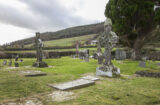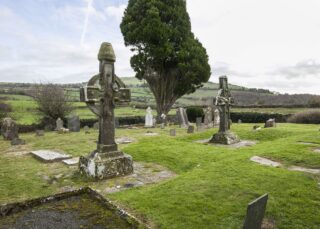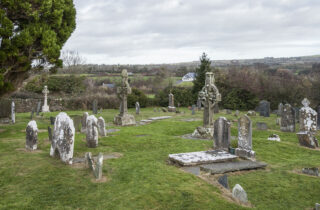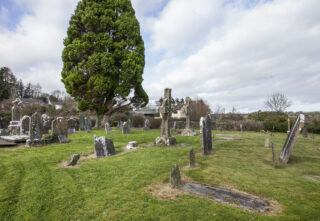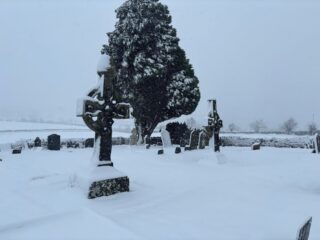Notice
Ahenny High Crosses are state-owned National Monuments in the care of the Office of Public Works
WARNING: It should be noted that these sites are unguided and a level of care and caution should be maintained during all stages of your visit. The Office Of Public Works (OPW) will not be held responsible for any damages, injuries, or losses that occur
Ahenny High Crosses
These high crosses from Ahenny form part of a group of high crosses identified within the kingdom of Lismore, known as the Denise. Other areas with high crosses are Kilkieran, Tibberaghny, Killamery and Kilree – collectively known as the Ossory Group. In early medieval Ireland, the Kingdom of Ossory was a powerful buffer state between the Laigin to the north and Eoghanacht to the west.
The Kingdom of Ossory was home to the Osraige people ruled by the Dál Birn, from the 1st century to the 12th century Anglo-Norman invasion of Ireland. Gilla Patráic mac Donnchada, was king of Osraige from 976 to 996, and his descendants went by the name of Mac Giolla Phádraig of Ossory (Son of the Devotee of St Patrick) better known as Fitzpatrick. Bernard Fitzpatrick, 2nd Baron of Castletown and Upper Ossory, and husband to Clare St. Leger of Doneraile Court Cork, was known, until his death, in 1937 as Mac Giolla Phádraig.
The two Ahenny high crosses are found in the monastic site of Kilclispen, 7km from Carrick-on-Suir, Tipperary and date to the 8th century. Both high crosses replaced earlier wooden versions. The first high cross, known as the north cross, is found on an east facing slope within the Kilclispen graveyard. This high cross, made of sandstone, measures 3.65m in height and has a conical capstone, thought to represent a bishop’s mitre. Visible intricate designs decorate the entire high cross. Starting at the steeped base, all four sides are adorned. A procession with a chariot is seen on the north side; a headless body on top of a horse with birds attacking the corpse and a man to the rear carrying a head is seen on the south side, also interpreted as David bring a defeated Goliath to Jerusalem; Adam naming animals is depicted on the east side, and seven cloaked figures carrying staffs on the west side is thought to depict a mission of the apostles. Its symbolism and craftsmanship lends a fascinating insight to early Irish Christianity.
The second high cross, known as the south cross measures 3.35m in height and its design is that of a ringed high cross with a low conical capstone. Again, carved out of sandstone and is highly decorated all over. The base is intricately carved on all four sides with each side divided in two by a cross relief. On the north side a hunting scene is depicted; on the south side this hunting scene continues with a person falling; on the east face it is interpreted that Daniel is in the lion’s den; on the west there is a carving but is now too worn to be deciphered.
Protect our Past - Click here to read about the importance of protecting our country’s unique heritage sites
This national monument is protected in accordance with the National Monuments Acts 1930 to 2014
Gallery
Nearby sites to visit
The Main Guard
A courthouse with centuries of history under its arches
Approx. 22.0 km from Ahenny High Crosses
Famine Warhouse 1848
The unlikely site of a bloody skirmish
Approx. 24.4 km from Ahenny High Crosses
Greyfriars/French Church
Ruins of a Franciscan Friary in the heart of the Viking Triangle
Approx. 25.9 km from Ahenny High Crosses
